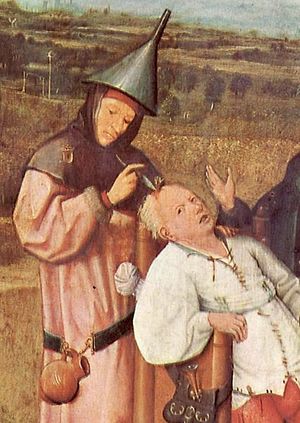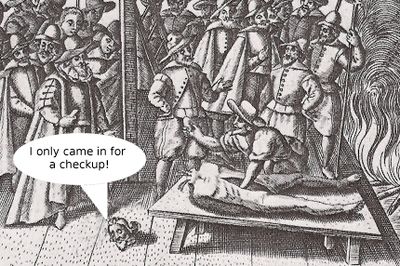User:MollyTheCat/Surgery
Surgery is a controversial form of alternative medicine. Surgery practitioners (known as surgeons) maintain that an ill person can be treated by cutting various bits off their bodies. According to surgeons, such treatment can lead to cures for a number of diseases.
Claims to the efficacy of surgery beyond the placebo effect are unsupported by the collective weight of scientific and clinical evidence. The claim that the removal of body parts can have a beneficial effect is scientifically implausible. The lack of convincing scientific evidence supporting its efficacy have caused surgery to be regarded by many as pseudoscience or quackery.
Current usage around the world varies from two percent of people in India using surgery in any one year to 15 percent in the United Kingdom and the United States, where it is considered part of traditional medicine.
History of surgery[edit | edit source]
In medieval times, surgery was unpopular with everyone (except surgeons) because there were no anaesthetics, antiseptics or nurses in sexy uniforms. However there was a widespread belief in the use of surgery and it was generally accepted that the common cold could be cured by amputation of the nose and that men could avoid catching the pox by have their bollocks cut off. Samuel Pepys wrote in his diary:
- "Today to the house of Sir Seymour Underware, where I find him in great disarray and complaining of much pain in his right foot. Methinks he suffers from the gout, brought on by the copious decanter of port which he quaffed yester-eve. Master Todd the surgeon was sent for and proceeded to cut off the offending foot. During and after this procedure, Sir Seymour continued to protest mightily, whereupon Master Todd effected to cut out the patients tongue. I can report that he protested no more and Master Todd has declared him fully cured."
Medieval surgeons often disguised themselves as barbers so that they could entice unsuspecting customers to have a haircut and then perform surgery on them. Surgeons always have a penchant for covering their heads, and medieval people were always warned to beware of barbers wearing unusual headgear.
Medieval surgery involved cutting into people's bodies with knives and sometimes sawing or drilling through bones using implements similar to those of a carpenter. The surgeon would then remove the particular body part that was the target of his operation and would sew up any holes left in the patient, using thick thread. With the advent of modern surgery, things are quite different in the following ways:
- The surgeon wears a nice green uniform and a mask.
- Er...there must be some other differences too.
Favourite body parts for surgery[edit | edit source]
The more flamboyant surgeons like their work to be noticed and prefer to remove obvious body parts such as arms and legs. However, many modern surgeons, particularly those who are just practising, prefer to remove less obvious parts—especially those that serve no real purpose.
In general, surgeons do not subscribe to theories of intelligent design, which propose that man was designed by a massively intelligent God. Instead, they go along with the theory that man was designed by a committee of highly-opinionated but unintelligent gods. The result was that man ended up created more-or-less in their own image but with various body parts that emerged from the committee, although they serve no useful purpose. These parts are a favourite target for surgeons: just as a homeopathic doctor might argue for the benefits of a medicine with no measurable active constituents, a surgeon will argue for the beneficial effects of removing any body parts which have no measurable function. Some examples are:
- The tonsils. These serve no useful purpose. Also they can be removed without making a big hole in the patient's body, so are good practice for the beginner surgeon.
- Appendix. An early version of the design for man was going to make a feature of this organ, but it was later dropped from the specification. However, the committee agreed that a stub should be included so that it could be developed in a future version of man. The appendix is another favourite target for surgeons, although this is a bit trickier than tonsils, as it requires making a hole in the right part of the body to find the thing.
- Gall bladder. I've no idea what this is for and nor have the surgeons, so it is another favourite.
- Intestines. Yes I know they are not optional but, when you cut someone open they flop around a lot and are very difficult to shove back into their proper space in the body. The best plan is to remove a bit so that they become a more manageable size. People are made with yards and yards of gut and they don't miss the odd few feet, or so.
- Testicles. Women manage quite happily without any, so they are another good target for surgery. Also, due to the way that man was designed, they ended up being tagged on as a rather unsightly afterthought, rather than tucked away neatly inside the body with all the other organs. Chop them off!
- Kidney. Yes, you need to have a kidney, but you certainly don't need two. Removal of one or other kidney can be undertaken by a reasonably experienced surgeon.
Even people who don't really accept the scientific basis for surgery will quite often go along with the idea of removing unnecessary body parts, as it is a very quick and efficient way of losing weight. If you add up the weight of an appendix, tonsils (maybe adenoids as well, which I forgot to mention before), a few feet of gut, a kidney, a gall bladder and possibly a bit of liver (you don't need it all), this is probably equivalent to about six months of dieting and has the added benefit of freeing up a lot of spare space inside your body. Slimmers take note!
The future of surgery[edit | edit source]
With the advent of stem cell research, it is now possible to grow bodily organs in test tubes. This opens up a whole new option for surgeons: instead of cutting bits out, they can stick extra bits in! For example:
- The heart. Think about it! You have two kidneys, two lungs, two ears, two nostrils, so why only one heart, when it is just about the most important organ in your body? With modern surgery, you can have a second heart fitted alongside the first. Proponents of surgery will argue that not only does this have benefits for your health but also it results in a more aesthetically pleasing and symmetric layout for the inside of your chest cavity.
- Lungs. Yes, you've got two already but, with an extra lung, just think how long you'd be able to hold your breath under water! (So say the proponents of surgery.)
- Penis extension. Who wouldn't welcome an extra couple of inches of knob? [Actually, don't try this one. From personal experience, it really doesn't work.]
- Arm joints. Why be stuck with the limitations of the wrist and elbow, when you can have an extra joint inserted in your arm. In future you'll be able to scratch that bit of your back that you can't quite reach and even be able to stick your elbows in your ears!


